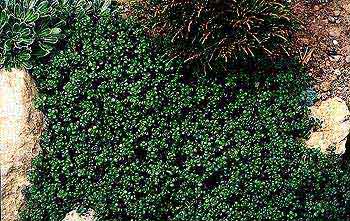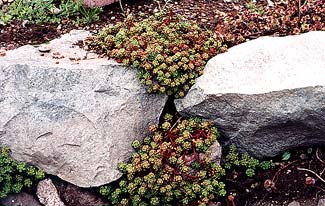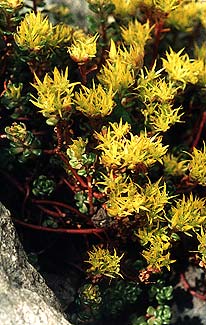
Oregon Stonecrop,
an Ultra-Hardy Native
"A thousand winding stairs lead down before us;
And one by one in myriads we descend
By lamplit flowered walls, long balustrades,
Through half-lit halls which reach no end."
-Conrad Aiken
(1889-1973)
(1889-1973)
Oregon Stonecrop (Sedum oreganum) is a common wildflower of northern California & Oregon, but also ranging all the way up to Alaska. There are places along the Columbia River where it spills over enormous boulders as the dominant groundcover, thriving on surfaces that seem to possess no soil.
It is rather too easy to grow & can be a little invasive. I have to discard portions of the patch shown above, which began as a small start, spread quickly, & would happy to overwhelm other short groundcovers if I let it go too long. It can be contained between taller sedums which have equally aggressive tendencies, since it is quite short & not much for climbing. It loves full sun but will do fine in partial shade.
 A second patch of it in another of our gardens is shown in the photo at the right. This one gets much more sun, in consequence of which it has obtained a blushing red to its chubby glabrous leaf rosettes. It is shown hanging over some rocks, from whence bits of it fell off below & self-rooted without having been planted.
A second patch of it in another of our gardens is shown in the photo at the right. This one gets much more sun, in consequence of which it has obtained a blushing red to its chubby glabrous leaf rosettes. It is shown hanging over some rocks, from whence bits of it fell off below & self-rooted without having been planted.Most Oregon Stonecrops develops the purplish tinge when grown in dry sunny locations, or where it experiences extremes of temperatures. The rosy patch is more exposed than the patch shown above which I presume stays green because it is close to the house & gets only morning sun. But I got the start for the greener plant from a completely different place, so it could be they are genuine color variations, as there are distinct races of the species along its extensive natural range. But I suspect it really is only because it's more sheltered; & it is perhaps significant that the protected patch has not only never gotten the red tinge, but has also never bloomed, indicating it wishes for more sun. I'm never going to move it, though, as even bloomless it provides such a winning fast-spreading groundcover where it's at.
 Oregon Stonecrop can be especially lovely in a contained area where it cannot go where unwanted, or on a stony ledge where little else apart from the hardiest sedums would grow in any case.
Oregon Stonecrop can be especially lovely in a contained area where it cannot go where unwanted, or on a stony ledge where little else apart from the hardiest sedums would grow in any case.In late spring & through much of summer it has yellow flowers on short stalks. The third photo shows the same plant as in the second photo, but in full bloom.
It's pretty hard to kill this stuff which is adaptable to any gardening zone hot or cold. It's one weakness is dampness. It needs a location of radically good drainage, & would far rather be growing over a rock than have its thick succulent rosettes sitting on damp soil.
It seems not to be commonly realized that the fat succulent leaves of Oregon Stonecrop are edible. Separated leaf rosettes can look like a bowl of reddish green "berries." The Kwakiutl people of British Columbia called Oregon Stonecrop "Crows' Strawberries." The tiniest stonecrop varieties can be used as a garnish. Berry-sized ones can be fried with other vegetables, or added to soups.
With Oregon Stonecrop which grows so swiftly anyway, eating the extra is better than just composting the weeded-back parts. Mostly it's the creeping sedums that are edible, but before testing them willynilly, note that a very few sedums are mildly toxic, such as Goldmoss Sedum (S. acre aurea), & can cause stomach upset if too much is eaten raw.
While noodling around the web I found a loony-tunes website that sold plants for their properties of magical healing. Oregon Stonecrop, just by having it near you, is supposed to cure you of close-mindedness. But golly, the first time I planted some of this stuff I was nine years old, & after a lifetime of exposure I still can't help but laugh at such prefabricrated superstitions foisted onto gullible minds in the dire hope of convincing them to spend their money.